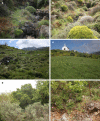Studies of life history of Gagea graeca (Liliaceae) based on morphological and molecular methods
- PMID: 28975526
- PMCID: PMC5626670
- DOI: 10.1186/s40529-017-0194-6
Studies of life history of Gagea graeca (Liliaceae) based on morphological and molecular methods
Abstract
Background: We studied the life history of Gagea graeca (L.) A. Terracc. (sect. Anthericoides) by field surveys on the Greek island of Crete, including quantitative analyses of 405 individuals, estimation of resource allocation by measuring the nitrogen content of different plant organs, assessing seed set and recording genetic diversity via amplified fragment length polymorphism (AFLP) analyses. In contrast to most species of the genus G. graeca seems to be a short-lived perennial, developing several characters that are rather typical for annual plants.
Results: Although seed set varies largely, flowering plants produce many (68 ± 79) small, flattened seeds (mean weight 73 ± 22 µg) in comparison to a single bulbil. If measured as nitrogen content of the respective plant parts, investment in seeds (25%) is much higher than that in bulbils (4%). In addition, the threshold for flower formation (expressed as bulb size where 50% of the plants form the respective structure) is with 2.17 ± 0.05 mm lower than that for bulbils with 2.80 ± 0.16 mm. This is in accordance with AFLP analyses revealing predominantly sexual reproduction (only 9.1% of 110 investigated plants belonged to clones).
Conclusion: In the genus Gagea early, predominantly sexual reproduction seems to be characteristic for species from arid habitats, coupled with a low proportion of clonal plants.
Keywords: Amplified fragment length polymorphism (ALFP); Drought adaptation; Reproductive biology; Resource allocation; Seed set.
Figures







References
-
- Ashman TL. Reproductive allocation in hermaphrodite and female plants of Sidalcea oregana ssp. spicata (Malvaceae) using four currencies. Am J Bot. 1994;81:433–438. doi: 10.2307/2445492. - DOI
-
- Beisenova S, Peterson A, Peterson J, Bersimbayev RI, Klahr A, Schnittler M. On the limits of drought—life history of Gagea bulbifera. Flora. 2015;210:72–79. doi: 10.1016/j.flora.2014.10.004. - DOI
-
- Danin A, Danin B (2015) Flora of Israel online. Jerusalem. http://flora.org.il/en/plants/. Accessed 10 Nov 2016
LinkOut - more resources
Full Text Sources
Other Literature Sources

